Twin Pagoda Temple & Chongshan Monastery
Twin Pogoda Temple
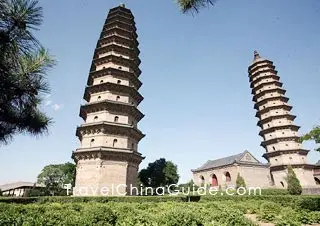 The Twin Pogoda Temple (Shuang Ta Si), also known by the name 'Yongzuo Temple' (Yong Zuo Si), is located in the southeast of Taiyuan City, Shanxi Province. There are two 53-meter-tall (170 feet) pagodas standing in it, hence the name 'Twin Pagoda Temple'. History records reveal that the temple and two pagodas were built under the Emperor Wanli's order in 1608 during the Ming Dynasty (1368-1644).
The Twin Pogoda Temple (Shuang Ta Si), also known by the name 'Yongzuo Temple' (Yong Zuo Si), is located in the southeast of Taiyuan City, Shanxi Province. There are two 53-meter-tall (170 feet) pagodas standing in it, hence the name 'Twin Pagoda Temple'. History records reveal that the temple and two pagodas were built under the Emperor Wanli's order in 1608 during the Ming Dynasty (1368-1644).
Each of the pagodas in Twin Pogoda Temple has 13 stories and is made entirely of bricks and stone. The exterior was sculptured in the shape of an octagon and decorated with the exquisite flying eaves. An internal staircase was added so that visitors can climb to the top of the pagoda and gaze far afield.
All of the buildings inside Twin Pogoda Temple were constructed with bricks. The brick-carved posts and brackets perfectly demonstrate the features of ancient Chinese architecture. It's worth mentioning that a rare collection of steles have been stored here that contain the handwriting of famous ancient Chinese calligraphers from various dynasties such as Wang Xizhi (303-361), Yan Zhenqing (709-785), Liu Zongyuan (773-819), and Su Dongpo (1037-1101).
The best time to pay a visit is in spring (April and May) when all the peony and cloves are in their full bloom. These beautiful flowers are said to have been planted during the Ming Dynasty and their beauty indeed makes the old temple more elegant and appealing.
How to get to Twin Pogoda Temple
Take Bus 55, 812, 820, or 873 to Shunagtasi (Twin Pogoda Temple).
| Entrance Fee | Apr. - Oct.: CNY 30 Nov. - Mar.: CNY 20 |
|---|---|
| Opening hours | 8:30 - 17:30 |
| Recommended Time for A Visit | 1h |
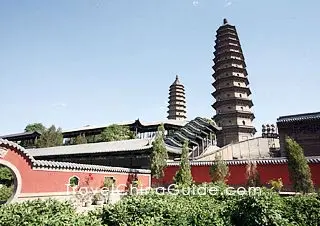 | 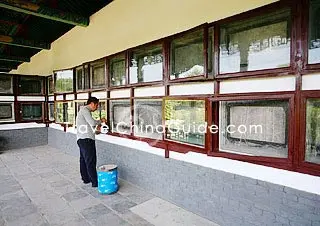 |
Chongshan Monastery
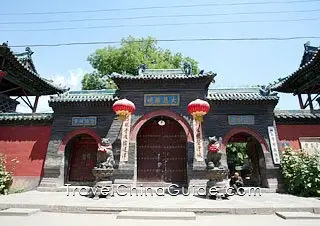 Initially built in the Tang Dynasty (618-907), the Chongshan Monastery (Temple for Appreciating Kindliness) was once called White Horse Monastery (Baima Si). It is located in Huangmiao Lane, Wuyi Road, Taiyuan City, Shanxi Province. In 1383, in memory of his mother, Zhu Gang, third son of Emperor Zhu Yuanzhang (1328-1398), first emperor of the Ming Dynasty (1368-1644) had the monastery rebuilt and extended, renaming it Chongshan Monastery.
Initially built in the Tang Dynasty (618-907), the Chongshan Monastery (Temple for Appreciating Kindliness) was once called White Horse Monastery (Baima Si). It is located in Huangmiao Lane, Wuyi Road, Taiyuan City, Shanxi Province. In 1383, in memory of his mother, Zhu Gang, third son of Emperor Zhu Yuanzhang (1328-1398), first emperor of the Ming Dynasty (1368-1644) had the monastery rebuilt and extended, renaming it Chongshan Monastery.
Construction was completed in 1391. The layout of the splendid palace-like monastery is evident from the extant Chongshan Monastery Construction Plan. Covering an area of 245 mu (40.4 acres), the Chongshan Monastery was obviously magnificent.
However, during the reign of Emperor Tongzhi (1856-1875) of the Qing Dynasty, the monastery was almost reduced to ashes. Today only one-fortieth of it survives, including the Bell Tower, the Dabei Hall, and the east and west wing rooms. Local governments have restored some of its former brilliance to the monastery.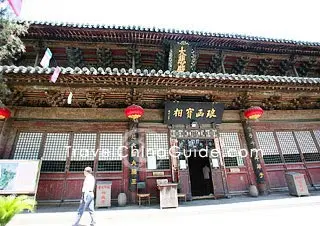 In these surviving buildings are three splendid treasures. One is the sutras. Chongshan Monastery is famous for the original edition of the sutras of the Song, Jin, Yuan, Ming and Qing dynasties kept here. The oldest sutra has a history of over 1,000 years. The second treasure is the 'Gem Paintings,' copies of two frescos still retaining their bright colors after 500 years. The third treasure is three gilded Ming Dynasty mud statues of Bodhisattvas all about 8 meters (26.2 feet) high. In the middle is Kwan-yin Goddess of Mercy, with her one thousand hands and eyes. All three statues still retain their florid colors and smooth lines, rare artworks of the Ming Dynasty.
In these surviving buildings are three splendid treasures. One is the sutras. Chongshan Monastery is famous for the original edition of the sutras of the Song, Jin, Yuan, Ming and Qing dynasties kept here. The oldest sutra has a history of over 1,000 years. The second treasure is the 'Gem Paintings,' copies of two frescos still retaining their bright colors after 500 years. The third treasure is three gilded Ming Dynasty mud statues of Bodhisattvas all about 8 meters (26.2 feet) high. In the middle is Kwan-yin Goddess of Mercy, with her one thousand hands and eyes. All three statues still retain their florid colors and smooth lines, rare artworks of the Ming Dynasty.
A Buddhist temple, Chongshan Monastery has become a key cultural relic under the protection of Shanxi Province and home to the Buddhist Association of Shanxi Province. The precious sutra and Taoist scriptures are not only examples of Chinese woodblock printing history, but of ancient Chinese calligraphy and carving arts luring accomplished monks, scholars and tourists.
How to get to Chongshan Monastery
Take Bus 3, 4, 61, 615, 805, 820, or 864 to Wuyi Lu Qiaotou Jiekou and then walk east for 5 minutes to the monastery.
| Entrance Fee | CNY 2 |
|---|---|
| Opening Hours | 8:00 - 17:00 |